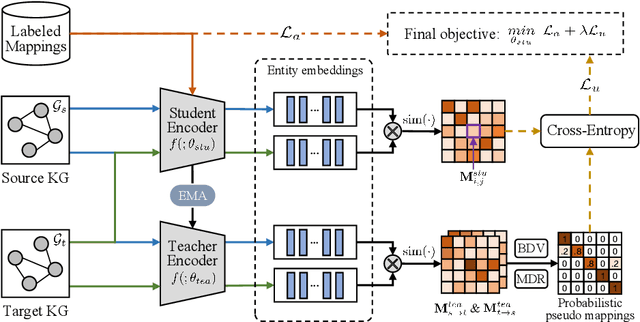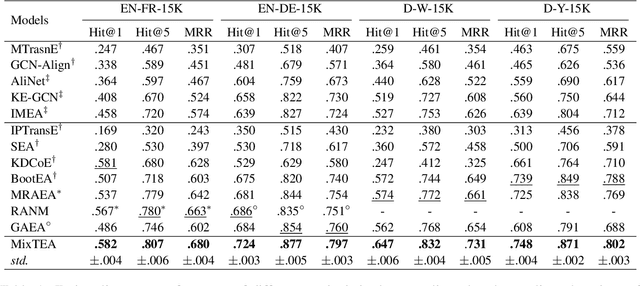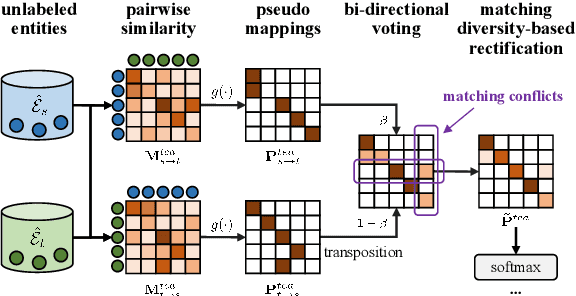Xiang Zeng
MixTEA: Semi-supervised Entity Alignment with Mixture Teaching
Nov 08, 2023



Abstract:Semi-supervised entity alignment (EA) is a practical and challenging task because of the lack of adequate labeled mappings as training data. Most works address this problem by generating pseudo mappings for unlabeled entities. However, they either suffer from the erroneous (noisy) pseudo mappings or largely ignore the uncertainty of pseudo mappings. In this paper, we propose a novel semi-supervised EA method, termed as MixTEA, which guides the model learning with an end-to-end mixture teaching of manually labeled mappings and probabilistic pseudo mappings. We firstly train a student model using few labeled mappings as standard. More importantly, in pseudo mapping learning, we propose a bi-directional voting (BDV) strategy that fuses the alignment decisions in different directions to estimate the uncertainty via the joint matching confidence score. Meanwhile, we also design a matching diversity-based rectification (MDR) module to adjust the pseudo mapping learning, thus reducing the negative influence of noisy mappings. Extensive results on benchmark datasets as well as further analyses demonstrate the superiority and the effectiveness of our proposed method.
NeRF synthesis with shading guidance
Jun 20, 2023



Abstract:The emerging Neural Radiance Field (NeRF) shows great potential in representing 3D scenes, which can render photo-realistic images from novel view with only sparse views given. However, utilizing NeRF to reconstruct real-world scenes requires images from different viewpoints, which limits its practical application. This problem can be even more pronounced for large scenes. In this paper, we introduce a new task called NeRF synthesis that utilizes the structural content of a NeRF patch exemplar to construct a new radiance field of large size. We propose a two-phase method for synthesizing new scenes that are continuous in geometry and appearance. We also propose a boundary constraint method to synthesize scenes of arbitrary size without artifacts. Specifically, we control the lighting effects of synthesized scenes using shading guidance instead of decoupling the scene. We have demonstrated that our method can generate high-quality results with consistent geometry and appearance, even for scenes with complex lighting. We can also synthesize new scenes on curved surface with arbitrary lighting effects, which enhances the practicality of our proposed NeRF synthesis approach.
Improving Knowledge Graph Entity Alignment with Graph Augmentation
Apr 28, 2023Abstract:Entity alignment (EA) which links equivalent entities across different knowledge graphs (KGs) plays a crucial role in knowledge fusion. In recent years, graph neural networks (GNNs) have been successfully applied in many embedding-based EA methods. However, existing GNN-based methods either suffer from the structural heterogeneity issue that especially appears in the real KG distributions or ignore the heterogeneous representation learning for unseen (unlabeled) entities, which would lead the model to overfit on few alignment seeds (i.e., training data) and thus cause unsatisfactory alignment performance. To enhance the EA ability, we propose GAEA, a novel EA approach based on graph augmentation. In this model, we design a simple Entity-Relation (ER) Encoder to generate latent representations for entities via jointly modeling comprehensive structural information and rich relation semantics. Moreover, we use graph augmentation to create two graph views for margin-based alignment learning and contrastive entity representation learning, thus mitigating structural heterogeneity and further improving the model's alignment performance. Extensive experiments conducted on benchmark datasets demonstrate the effectiveness of our method.
 Add to Chrome
Add to Chrome Add to Firefox
Add to Firefox Add to Edge
Add to Edge